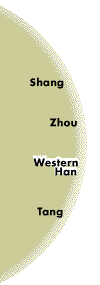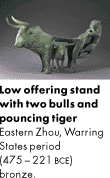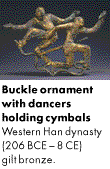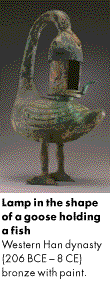 |
 |
 |
 |
 |
  |
 |

The kingdom of Dian in Yunnan Province, which reached
its height during the second and first centuries BCE, was
one of the richest ancient civilizations in southwestern
China. The frank realism and exotic imagery of the
bronzes from the Dian kingdom illustrate the foreign
heritage of its people and the huge distances, both
culturally and artistically, separating them from the Han
court. All Dian bronzes on exhibit were cast using the
lost-wax technique, which allows intricate, highly
sculptural designs.
Two dancers wearing fitted trousers and short tunics
form a buckle ornament that illustrates central Asian
influence on Dian culture, as their garments are typical
of the horse-riding tribes of central Asia. Similarly,
the offering stand, with its theme of animal combat,
derives from the animal style of the Eurasian steppes.
Bulls appear to have had special significance in Dian
ritual and sacrifice.
|
 |
 |
 |
 |
By the Han dynasty much of
the bronze industry was devoted to making bronzes of
ingenious design for secular instead of ritual use. This
lamp in the shape of a wild goose has a thoughtful,
ecologically minded design. As the wick burns in the
cylinder on the goose's back, the vertical panels that form
the cylinder can be slid back and forth to direct the light
where it is needed. The smoke from the burning oil rises up
and is channeled through the fish-shaped cover into the
neck of the goose. From there it descends into the
water-filled hollow body where it is absorbed and, thus,
prevented from polluting the air. Lamps in a variety of
animal and human shapes were among the most creative
products of the Han bronze industry. |
 |
 |
 |
 |
A magical mountain range,
home to a melee of real and imaginary animals, people, and
plants, extends over all four registers of this chariot
fitting. Dragons and phoenixes, owls, deer, and
bears-animals found in China or Chinese myth-mingle with
the creatures of southern and western Asia: top-knotted
foreigners are shown riding elephants and camels, a mounted
bowman aims a Parthian shot at a tiger, and swift horses
are depicted with wings. Many of these creatures were
considered auspicious omens. The political power of the
expansive Han dynasty, which extended into southeastern and
central Asia, made the peoples and creatures of China's
borders known-although not familiar-to the Chinese. Bronzes
such as this were exotica and they are shown here enhanced
by lavish inlays of gold, silver, and turquoise, colors
that might have approximated the brightly appliquéd
felts and other fabrics worn by the border peoples.
 |
 |




